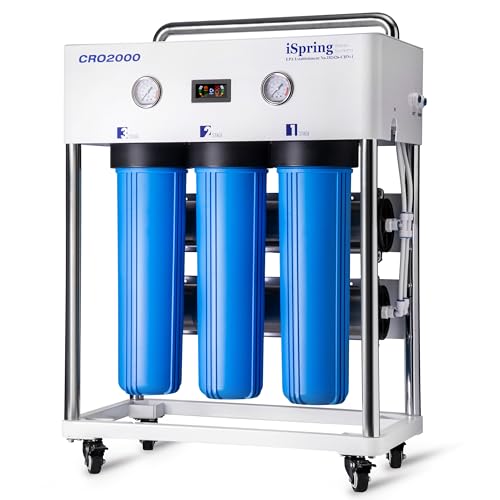The Best Reverse Osmosis System Under $2000 of 2026 - Latest Updated
Michael Greene Jan 7, 2026 3:49 AM
Different customers have different requirements for the best reverse osmosis system under $2000. To help you find the perfect one for your needs, our research team has compiled a list of the 7 best reverse osmosis system under $2000 on the market, complete with their most advantageous features.
Top Choice
-
Apec Water Systems TO-SOLUTION-15 Whole House Water Filter
-
iSpring CRO2000 5-Stage Tankless Commercial Reverse Osmosis Drinking Water Filtration System
-
3M Aqua-Pure Under Sink Reverse Osmosis Water Filter System WECO CRO5075 Countertop Reverse Osmosis Drinking Water Purification System
- GB SCORE-
GB SCORE is a ranking system developed by Guessbest.com. Guessbest.com has no relationship or impact from any manufacturers or sales agent websites. Learn more
- BrandWaterdrop
Waterdrop X12-Alkaline Mineral pH+ Reverse Osmosis System, NSF/ANSI 42&58&372 Certified,
View on Amazon- GB SCORE-
GB SCORE is a ranking system developed by Guessbest.com. Guessbest.com has no relationship or impact from any manufacturers or sales agent websites. Learn more
- BrandWaterdrop
- GB SCORE-
GB SCORE is a ranking system developed by Guessbest.com. Guessbest.com has no relationship or impact from any manufacturers or sales agent websites. Learn more
- BrandWECO
- GB SCORE-
GB SCORE is a ranking system developed by Guessbest.com. Guessbest.com has no relationship or impact from any manufacturers or sales agent websites. Learn more
- BrandKINETICO
- GB SCORE-
GB SCORE is a ranking system developed by Guessbest.com. Guessbest.com has no relationship or impact from any manufacturers or sales agent websites. Learn more
- BrandAPEC WATER
- GB SCORE-
GB SCORE is a ranking system developed by Guessbest.com. Guessbest.com has no relationship or impact from any manufacturers or sales agent websites. Learn more
- BrandiSpring
- GB SCORE-
GB SCORE is a ranking system developed by Guessbest.com. Guessbest.com has no relationship or impact from any manufacturers or sales agent websites. Learn more
- BrandAqua-Pure
Last update on 2026-01-07 / Affiliate links / Images, Product Titles, and Product Highlights from Amazon Product Advertising API
1. What are the key benefits of a reverse osmosis system under $2000?
A reverse osmosis (RO) system under $2000 offers several benefits:
- Cost-effectiveness: It provides high-quality filtration without the premium price tag of more expensive systems.
- Improved water taste and odor: Removes contaminants like Chlorine, Sediment, and other impurities, resulting in better-tasting water.
- Space efficiency: Many models are compact and can fit under sinks, saving space.
- Ease of maintenance: Generally easier to maintain compared to complex, higher-end systems.
2. How does a reverse osmosis system work?
A reverse osmosis system works by using a semi-permeable membrane to remove contaminants from water. Here's a simplified process:
- Filtration: Water passes through a pre-filter to remove sediment and chlorine.
- Reverse Osmosis: Pressurized water is forced through a semi-permeable membrane that filters out dissolved solids, contaminants, and impurities.
- Post-filtration: The purified water goes through a post-filter to further enhance taste and quality.
- Storage and Dispensing: Clean water is stored in a tank until needed, typically through a separate faucet at the sink.
3. What contaminants can a reverse osmosis system remove?
A reverse osmosis system can effectively remove a wide range of contaminants, including:
- Heavy metals: Such as Lead, Arsenic, mercury, and cadmium.
- Dissolved solids: Including salts, nitrates, and sulfates.
- Chemicals: Like chlorine, pesticides, and herbicides.
- Microorganisms: Such as bacteria, viruses, and some protozoa.
4. How often should filters be replaced in a reverse osmosis system?
Filter replacement frequency can vary based on usage and water quality, but generally:
- Pre-filters: These need replacement every 6-12 months, depending on sediment levels and local water conditions.
- RO membrane: Typically lasts 2-3 years before needing replacement, depending on water hardness and contaminants.
- Post-filters: Replace every 6-12 months to maintain water taste and quality.
5. What should I consider when choosing a reverse osmosis system under $2000?
When selecting a system in this price range, consider these factors:
- Water quality: Ensure the system effectively removes contaminants present in your water supply.
- Capacity: Choose a system with an adequate production rate to meet your household's water usage.
- Ease of installation: Some systems may require professional installation, while others are designed for DIY installation.
- Brand reputation and reviews: Look for reputable brands with positive customer feedback regarding performance and reliability.
- Additional features: Such as remineralization filters, leak detectors, or water quality indicators, depending on your preferences and needs.

























